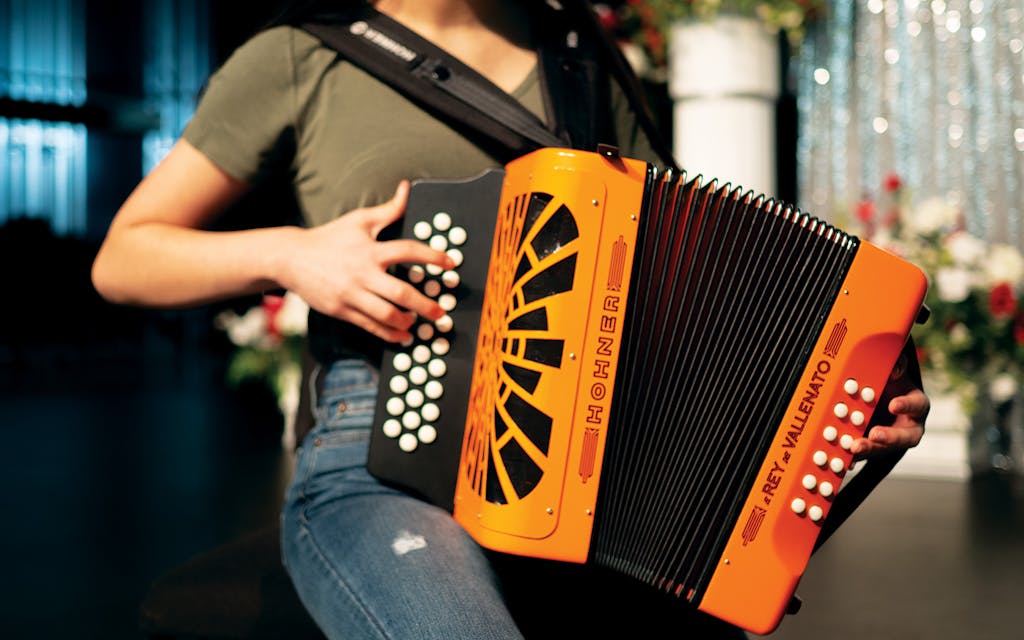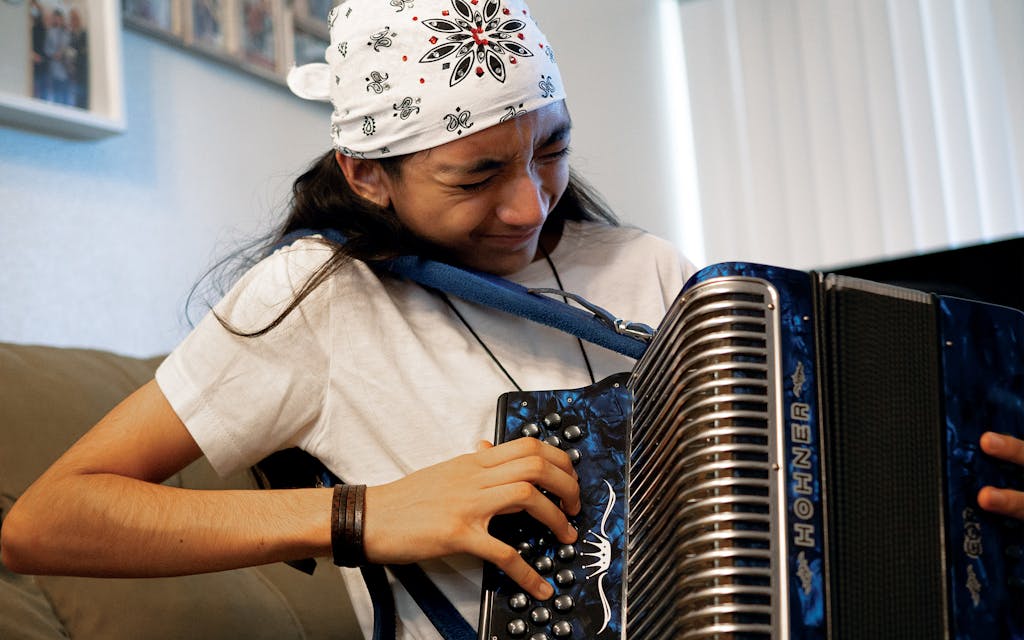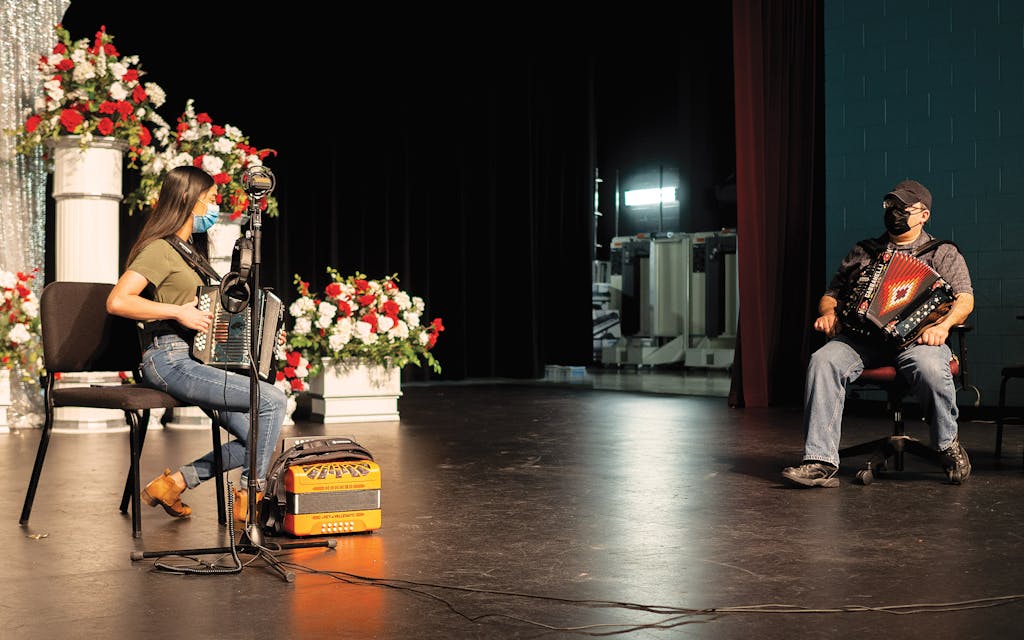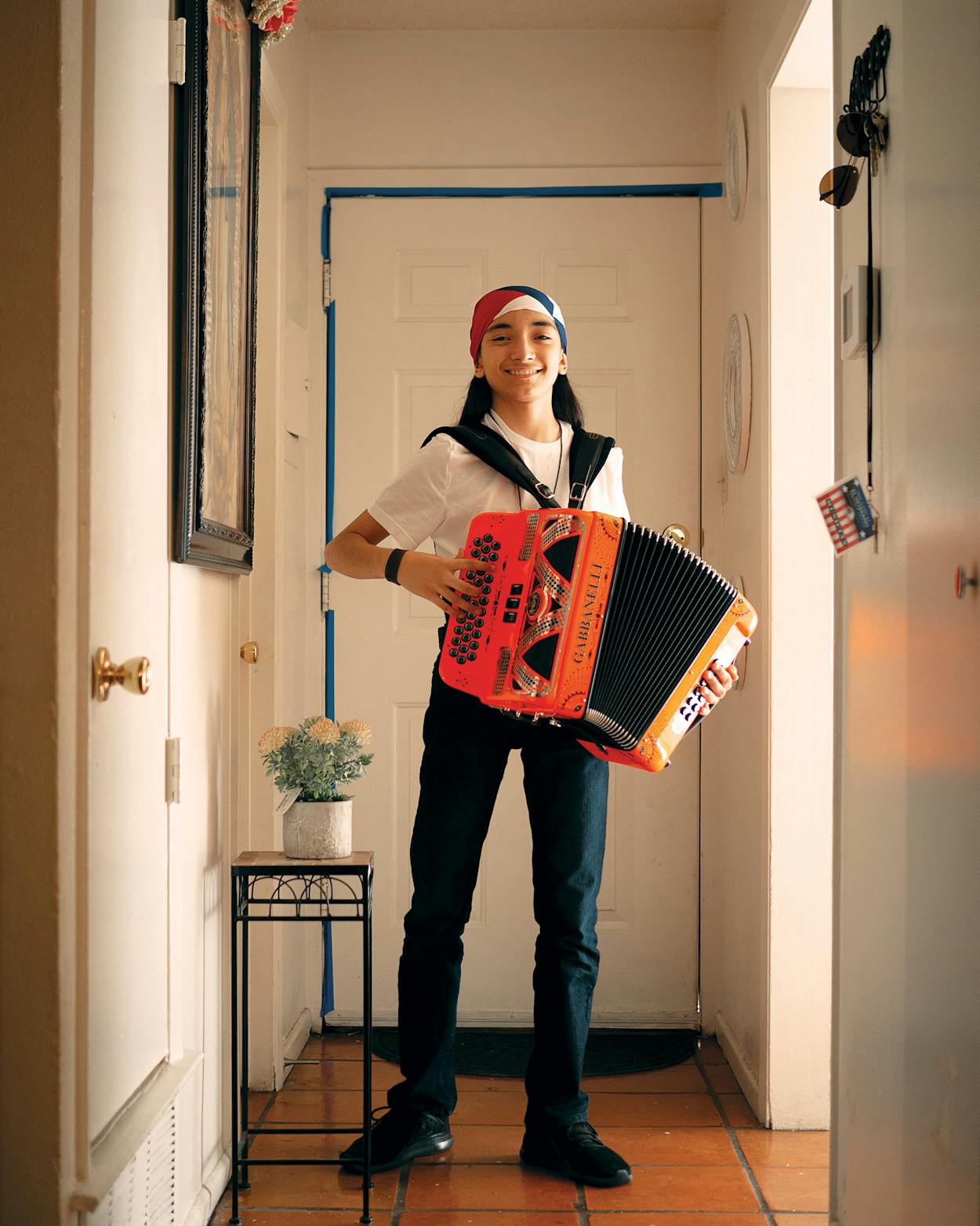Had this been a non-pandemic year, Christopher Ramirez and Ashly Nicole Molina would have been in Austin on a recent Saturday afternoon. As two of the four finalists for the sixteen-and-under conjunto category in the Big Squeeze—the annual competition of Texas’s best young accordion players—they would’ve played live at the Lone Star Plaza in front of the Bullock Texas State History Museum. They would’ve felt the butterflies in their stomachs that come from standing onstage in front of a crowd, playing in front of judges, family, and other competitors. And as they did, extending and compressing the accordions’ bellows that breathe life into the instruments, moving their bodies to the rhythms and sounds, they would’ve felt that anxiety melt away.
But because of the pandemic, like every contestant in all four of the Big Squeeze’s categories—polka, zydeco, cajun, and conjunto—Ramirez and Molina submitted virtual entries for the May 8 contest. Each musician recorded him- or herself playing two songs. They were graded on technical skill, song interpretation, and stage presence, even though judges admitted that the latter was difficult to convey in a video audition.

Ramirez, fourteen, a San Antonio eighth grader with jet-black hair that goes past his shoulder blades, played “Stocky Polka” and “Picame Tarantula” on his light orange Gabbanelli accordion. He selected those songs because they’re two of his favorites—something about their chords touches his heart, he says. It’s the same feeling he had the first time he heard a strange sound coming from the radio, when he was about nine years old. His parents told him it was an accordion. Later, at a San Antonio music festival, he not only heard it again but also saw the instrument making that sound. He returned home and tried to make his own. “I grabbed a little paper,” Ramirez remembers. “Drew the buttons, trying to simulate the accordion.”
When Christmas came and he got an iPad, he started playing an accordion game. That’s when his parents knew their son was serious about playing the instrument that’s been a part of Texas’s culture for more than 170 years. They soon gave him an accordion and signed him up for lessons, and he’s scarcely stopped practicing since. This year was Ramirez’s third time competing in the Big Squeeze, which is organized by the nonprofit Texas Folklife. Roughly 35 young musicians from across the state—and from Louisiana, in the cajun and zydeco categories—participated this year. Now in its fifteenth year, the event aims to help preserve and promote Texas’s traditional cultural practices.
That includes playing the accordion, which German settlers brought to Texas and northern Mexico in the mid-1800s. Texas Mexicans soon adopted the instrument and made it their own, blending German polkas and waltzes with Mexican music to create the style that would later become known as conjunto. The instrument’s versatility was key to its appeal. “Poor rural Tejanos took to it quickly since it could mimic several instruments simultaneously and it was cheaper to pay one acordeonista than an orquesta,” writes Carlos Guerra in the book Puro Conjunto. By the early 1900s, the accordion was widespread on both sides of the border.


For her two songs at the Big Squeeze, Molina, a sixteen-year-old sophomore from Roma, played “Nicolasa” and “Yolanda” on a black-and-gray Hohner Panther accordion. Molina grew up listening to conjunto, but became an accordionist almost by accident. She was in middle school and wanted to learn the bajo sexto—the twelve-stringed, guitar-like instrument that, starting in the 1930s, was paired with the accordion to create conjunto’s soul—but couldn’t. “Since the program was new to middle school, we could only play the accordion,” Molina says. “I gave it a try and I realized that I really liked playing it.”
Intelligent and dedicated, sometimes practicing as often as three times a day, Molina picked up new songs quickly. If her instructor showed her how to play part of a song on a Monday, by Tuesday, she had perfected it. Soon, she had a favorite accordion player: Ramón Ayala.
Known as the “King of the Accordion,” Ayala lives in Hidalgo, a little more than an hour southeast of Molina’s home, and across the border from where his career began inside Reynosa’s dark cantinas.
There, on both sides of the border along the Rio Grande Valley and into South Texas, is where conjunto music developed. Its roots are thoroughly working-class. This music is inseparable from the place where it was born—a little like New Orleans and jazz—passed on from one generation to the next. Some conjunto students can trace their musical lineages back to the pioneers—those who founded the genre, then taught it to others, who then taught it to others.

Aaron Salinas was a curious child. One day, while in his grandparents’ home, looking around their closet, he found something he’d never seen.
“Hey, what is this?” he asked his grandmother. She told him it was his grandfather’s accordion and that, once he got home from work, he’d show him how it worked. Salinas’s grandfather had learned from Valerio Longoria, a conjunto pioneer from the South Texas town of Kenedy who spent part of his youth in the Rio Grande Valley. In the 1930s, Longoria traveled with Mexican and Tejano farmworkers. At night, he played his accordion and the music that reminded them of home. He later traveled across the country, playing conjunto everywhere he went for a quarter a song.
When Salinas’s grandfather got home, he showed Salinas a few notes. Soon after, he enrolled his grandson in lessons at Conjunto Heritage Taller in San Antonio, the city where many of conjunto’s pioneers lived and performed. Salinas, 26, now teaches at the same place he learned to play. Because of the pandemic, the organization has switched to virtual lessons. It’s “a more modern approach,” Salinas says, to teaching the music that’s survived for more than a century. In 2014, Salinas won the Big Squeeze. When we spoke in late April, he was hoping that Ramirez, his student, whom he calls a prodigy, would do the same.
“He’s a great kid all around,” Salinas says of his student. Ramirez is the type of kid who says “God bless you” before he ends a phone call. Even though he gets nervous, he can’t wait to play on stage again. “I really like how it feels,” Ramirez says of performing live. When he plays, his long fingers look like the legs of a tarantula dancing on the accordion’s keys. “I really like how the music pumps in your heart.”
Every night after finishing his homework, Ramirez practices up to three hours. If he has more time, he’ll practice longer. “My favorite thing to do is play music,” he says. Winning the Big Squeeze “would be something that would really fill my heart.”

“The accordion is a very difficult instrument to learn,” Jaime Lozano says. “It requires a lot of your time in practice every day.” Lozano, 44, has been around music most of his life. Born and raised in Roma—a city on the Texas-Mexico border rich with musical history—he began as a drummer at 12 years old. Soon, he was playing with “old-timers” to earn extra money.
Today Lozano, along with his brother, Jesus, is the director of the conjunto program at Roma High School. Over the past seven years, the two men have built a competitive program from nothing. When they began, there were just enough students to fill two class periods; now, there’s so much interest that the school holds competitive auditions. “The demand has been crazy,” Lozano says.
Roma High School participated in the Big Squeeze for the first time in 2018. Since then, every year, its students have won at least one of the two conjunto age categories. Last year, Roma students won both age divisions. Roma is a powerhouse among Texas high school conjunto programs; it is to conjunto competitions what the University of Alabama is to college football.
With that success, Roma administrators expanded the program to middle school. That’s where Molina first joined and discovered she had a natural talent for the accordion. She’s been playing for a little more than two and a half years. She says that because she hasn’t performed in front of people much, she still gets nervous. “But other than that,” she says, “I feel very proud when I perform.”
Molina has made it a habit of practicing often, even during the pandemic, when virtual lessons over Google Classroom have made things more difficult. Still, she’s confident in her ability. “If I won, it would mean a lot,” Molina says of the Big Squeeze. “Because I put a lot of hard work and dedication to it.” Along with other prizes for winning, she would also get her own accordion. The one she uses now is a loaner from her school.


Next year, the Big Squeeze will likely return to its home at the Bullock Museum in downtown Austin. After a day of performance, kids, parents, and teachers usually gather on the museum’s front lawn to await the final results. Ramirez and Molina would’ve been there, along with the other under-sixteen finalists—Roberto Flores from Peñitas and Galilea Paz from Rio Grande City, who is also part of Roma High School’s conjunto program—waiting, in person, to hear the results of the 2021 Big Squeeze.
This year, everyone watches on Facebook Live. Ramirez tunes in from San Antonio; Molina logs on from Roma. If Ramirez wins, he’ll become the youngest competitor to win the Big Squeeze. If Molina triumphs, it will be the fourth consecutive year someone from Roma High School has won the contest.
“In the sixteen-and-under age category . . . ” begins Sarah Rucker, the Big Squeeze’s program director, preparing to announce the winner. For previous competitions before the pandemic, she and other members of the Big Squeeze team would drive around Texas in the months leading up to the finals, hosting at least eight showcases (from which semifinalists are selected) and looking for the state’s best young accordion players. As she talks, even from hundreds of miles away, you can feel a slight tension.
“From Roma, Texas, please welcome Ashly Nicole Molina!” Rucker says, before the camera switches to this year’s best young accordion player in the sixteen-and-under conjunto category.
Molina thanks her parents, directors, family, friends, and teachers. She says they’ve all given her unconditional support. It’s the type of support on which conjunto music has survived and, in parts of Texas, thrives. It’s in these places—largely along both sides of the Rio Grande Valley national border and into South Texas—where children, sometimes starting when they’re barely strong enough to hold a full-sized accordion, learn to play the traditional music that makes people dance.
Before his death in 2000, Valerio Longoria gave an interview for the Los del Valle Oral History Project at the University of Texas Rio Grande Valley. He said that while performing was a joy, one of the most rewarding parts of his career was passing on the tradition to the next generation of Texans. For twenty years, he taught the accordion at the Guadalupe Cultural Art Center in San Antonio. “I have taught thousands of children,” Longoria said. “I see myself in them.”
- More About:
- Music
- San Antonio
- Rio Grande Valley
- Austin






